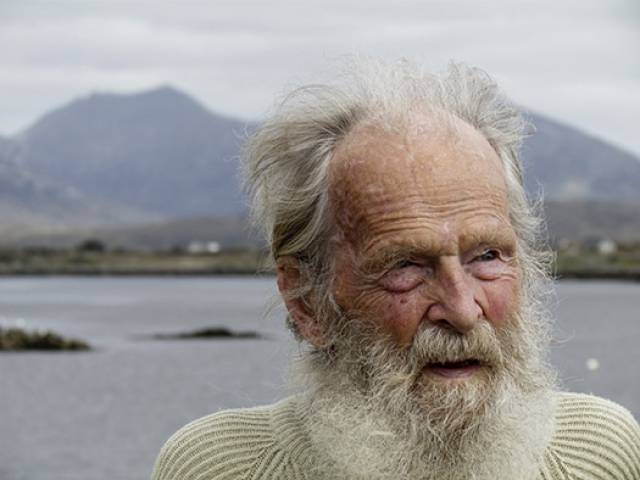The passing of Mickey d’Alton of Killiney at the age of 95 further reduces our direct links to an increasingly remote era. A noted navigator, voyager and enthusiastic Dublin Bay sailor, his background and education were such that he spoke with total clarity in an unmistakable Dublin accent of a very specific type in a voice now almost entirely of a bygone era, a voice which is heard in the few extant recordings made of George Bernard Shaw as he held forth with his clearcut opinions on some topic of the day.
Clearcut opinions on many topics were likewise Mickey d’Alton’s approach to the human condition, for he was someone who lived life to the full with all the extra zest of a survivor of active service in World War II. As a young lietutenant, he commanded a landing craft at D- Day in Normandy in June 1944, and though his war experience was one of the few subjects he didn’t linger on in conversation if it arose as a topic at all, this aspect of his long and well-lived life came centre stage in January 2015 when a remarkably moving ceremony aboard the French naval vessel Somme, which came to Dublin Port specially for the occasion, saw the French ambassador honour Michael d’Alton as a Chevalier de la Legion d’Honneur, while he also received the United States Veterans Distinguished Services Award.

Michael d’Alton as a Chevalier de la Legion d’Honneur and recipient of the United States Veterans Distinguished Services Award
This exceptional gathering on board ship provided a unique opportunity for many strands of his life to become one, as it brought war veterans from home and abroad – there was a large American contingent – together with his family and his many sailing friends from a life afloat which went back to the late 1930s.The sudden prominence given to his war service also provided an opportunity to savour the clearheaded d’Alton take on many topics, and reminded us of his approach to the matter of Ireland’s neutrality in World War II.
Until recently, despite the fact that Sweden, Switzerland and Spain stayed neutral throughout World War II without drawing obloquy upon themselves, Irish neutrality was a bone of contention even though Irish rebel forces had been at war with Britain only eighteen years earlier, and more recently there’d been Civil War in 1922 over the resulting peace treaty. Thus if Eamonn de Valera had led Ireland into World War II on either side, it would have resulted in another Civil War, whereas the policy of careful neutrality, while not being totally hostile to the Allied cause against Germany, was in fact the best solution to a wellnigh intractable policy problem.
While historians may still argue about it today, a searchlight of pure common sense was shone into this sometimes murky corner in June 2014 at the 70th Anniversary of the Normandy Landings in France, when Mickey d’Alton, as part of an Irish contingent, was interviewed about his experiences and asked how he had felt about Irish neutrality.
His typically clear-sighted analysis was like a breath of fresh air, a clarion call of sound reasoning. Mickey d’Alton thought that Irish neutrality had been the best possible way forward, indeed the only possible way. Apart from the very real risk of another Civil War just 17 years after the previous one had ended with much bloodshed, if the government had decided to enter the new war, then had they done so on the German side – which some wanted – there would have been immediate invasion from Britain.
But had they gone in on the Allied side, he said, then the Allies would have been obliged to re-direct already limited resources to help in the defence of Ireland’s long coastline and almost entirely unprotected countryside and cities. As it was, Neutrality was the best solution, as it provided a steady supply of enthusiastic recruits to the Allied cause, an additional source of food supplies across the Irish Sea, and it also was somewhere which provided a useful recuperation area for servicemen on leave.
His notable war service having been properly honoured sixteen month ago, today with his passing we recall his extraordinary sailing career. He was a Dublin Bay Sailing Club man from an early age, and through his long linkup with the formidable Dr Ninian Falkiner -who was to go on to be Commodore of the Royal Irish YC from 1968 to 1972 - the Royal Irish YC became the d’Alton shoreside base, and he also went on to join the Irish Cruising Club in 1956.
As soon as the war had ended, he resumed a sailing career – both inshore and offshore – of the highest achievements. Meanwhile his life ashore was been one of abundant energy and many interests. Although a Chartered Quantity Surveyor, in his fifties he returned to college to study arbitration, and then went on to post graduate qualifications which have seen him negotiating and hearing cases at the highest international level.
He married a kindred spirit in Mabel, and their two children Mark and Sonda bring the same lively intelligence to everything they do, with a marked emphasis on outdoor life. As to Mickey’s sailing, although his proven success and perfectionism as a navigator in the era long before radio and electronics took over made him set the highest standards for his shipmates, he has always had the happy knack of teaming up with people whose abilities and resources neatly match his own skills, so much so that while he has owned a couple of boats, they have always been in partnership with kindred spirits.
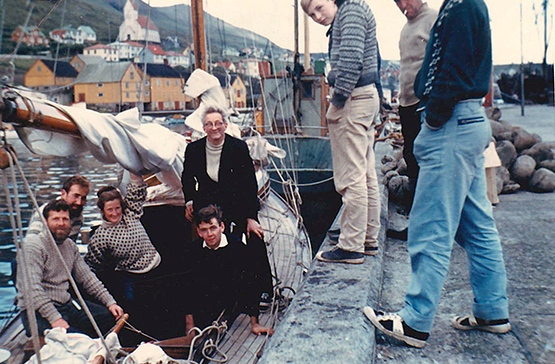
Crew of DB24 Euphanzel on arrival in the Faroes, 1961. They are (left to right) Mickey d’Alton, Michael O’Rahilly, Mabel d’Alton, Ninian Falkiner, and Tim Kane.
His most renowned sailing achievements were as navigator and effectively sailing master with Ninian Falkiner, a pillar of the Dublin medical establishment, with whom Mickey formed a very fruitful sailing partnership from 1944 until Ninian Falkiner’s death in 1972, their sailing relationship beginning with a Dublin Bay 21.
Their best-known achievements were with the Dublin Bay 24 Euphanzel from 1948 until 1965. Gradually they built up their expectations with short cruises and offshore races, but in 1956 they hit the big time with a cruise from Dublin Bay through Scotland’s Caledonian Canal to Norway, then across to the Shetland Islands following which – the weather being favourable – they simply sailed on across the open Atlantic in a sou’westerly direction for hundred of miles until they reached St Kilda, regarded as Ultima Thule in those days.
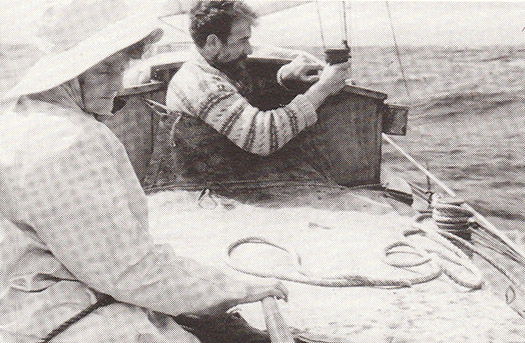
The “d’Alton Cover” over Euphanzel’s non-self-draining cockpit during the Faroes cruise of 1961, Mabel d’Alton on helm, Michael O’Rahilly taking a bearing.
For this cruise, they were awarded the Irish Cruising Club’s premier trophy, the Faulkner Cup. To put it in perspective, remember that as soon as Euphanzel got back to Dublin Bay, she returned to being a One Design boat in a Dun Laoghaire class raced regularly with the greatest possible vigour. Yet most summers they cruised as well, in 1961 going to the Faeroes with a special kayak-style cockpit cover developed by Mickey as the DB 24s didn’t have a self-draining cockpit, and he reckoned they’d get their come-uppance one day. It duly happened on the way back – they were hit by a sudden and relatively unforecast Force 9 but the “d’Alton Cover” worked a treat, while their thoroughbred boat continued to make to windward in horrifying seas, with Mickey’s navigation spot-on in almost zero visibility.
Having experienced one full gale and more in open water, when another one was forecast on the southward passage while still off the Scottish coast, they ensured that they found a snug berth with two anchors out in the prefect shelter of Loch Swen. The gale duly went through in the night with torrential rain, but the morning brought peace with the evocative sound of a lone piper wafting down the nearby hillside.
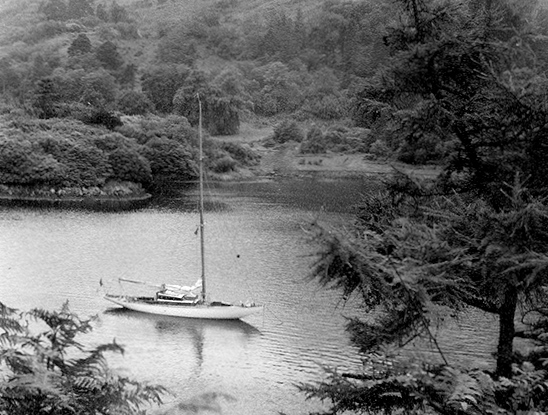
The calm after the storm. Euphanzel in Loch Swen the morning after a severe gale, with the sound of a lone piper wafting down the hillside.
1964 saw a last hurrah with Euphanzel with a round Ireland cruise, then the following year Ninian Falkiner was one of those who went with the modernizing of Dublin Bay sailing, as he bought a brand new all fiberglass van de Stadt-designed Excalibur 36 which he called Tir na nOg. The mixture of local and offshore racing and extensive cruising which had become established with Euphanzel was continued, but after five years Ninian and Mickey felt they’d done their duty by glassfibre, and the last boat for the team was the 12-ton Nicholson designed timber sloop Felise, which in 1970 they cruised to the Lofoten Islands in northern Norway.

Wearing his newly-conferred Legion d’Honneur medal, Mickey d’Alton remembers old times with James Nixon, who was a shipmate aboard Euphanzel during the round Ireland cruise of 1964, and on Tir na nOg to the Faroes in 1966. Photo: W M Nixon
With Ninian’s death in 1972, Mickey became involved in partnership with a 25ft Glen OD, while his most notable cruising achievement during the mid ’70s was as navigator for Paul Campbell aboard the latter’s 37ft Tyrrell-built yawl Verve, which in 1975 they sailed out to Rockall where, from a dinghy rowed by Mickey, crewman Willie Dick, who had extensive rock-climbing experience, became possibly the first person - certainly the first yachtsman - to land directly on that tricky bit of rock, as any previous known landings had been by helicopter.
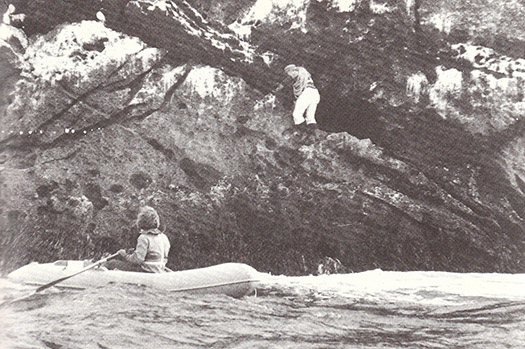
The Rockall landing in 1975 from Paul Campbell’s Verve. Mickey d’Alton is manoeuvring the dinghy, while Willie Dick has just managed to grasp a handhold after juming on to the rock face.
By this stage in life with his sixties approaching, Mickey d’Alton’s sailing programme might have been expected to slacken. But war veterans cherish their freedom to go sailing as and when they please, and they cherish it far too much to think of easing off, let alone retiring.
So what is arguably the best part of Mickey d’Alton’s sailing and cruising career was about to begin. He linked up with fellow senior sailors Franz Winkelmann and Leslie Latham, and they bought themselves a Ruffian 23 – Siamsa – which gave double value as she provided them with regular One Design racing in Dublin Bay, and thanks to modifications mostly made by Mickey – sometimes utilizing unexpected items of equipment in unusual ways – she was turned into a very able little cruiser.
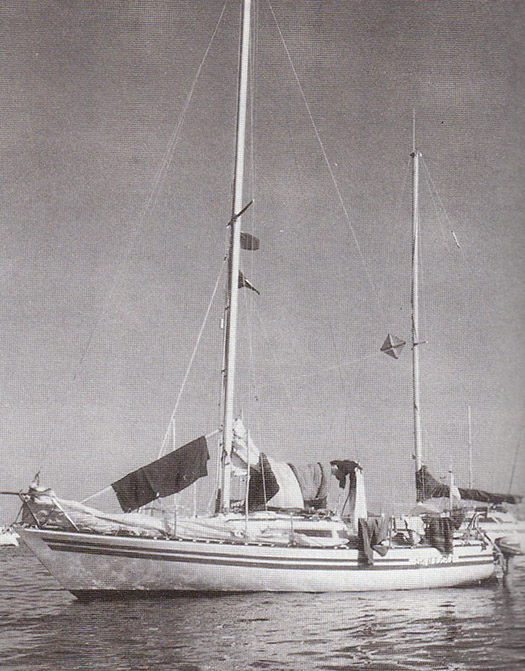
The Ruffian 23 Siamsa “airing out” during the 1997 cruise from Dublin Bay to the Isle of Scilly. Three very senior sailors managed to cruise thousands of miles in this very able if decidedly small boat.
And by heavens, how these three old guys cruised their little boat. It was all the more remarkable as Franz was all of 6ft 2ins tall, and more or less had to be folded in two if he was going to get below, while Leslie was so old his age was never mentioned. As for Mickey, his only concession to the passing years was that his vigorous hair and bushy beard were allowed even more freedom of movement and growth, and he looked like someone sent out from Central Casting to be the Old Man of the Sea.
The years may have been passing, but the enthusiasm for sailing never dimmed. Of their many cruises to many places, one of my favourites has to be the cruise to St Kilda in 1983. Siamsa’s only auxiliary engine was an outboard so small it could only push them in and out of port in a calm, otherwise they were sail only, so in getting to St Kilda they dealt with headwinds simply by keeping sailing, and kedging in the nearest handy roadstead when the tide turned against them while beating through the Irish Sea and North Channel.
Maintaining a viable way of life in a 23-footer without standing headroom would have been a challenge to most sailors, but the crew of Siamsa just kept plodding along, they’d experienced it before, they knew they’d get there in due course, and meanwhile weren’t they sailing and having a very satisfying time?
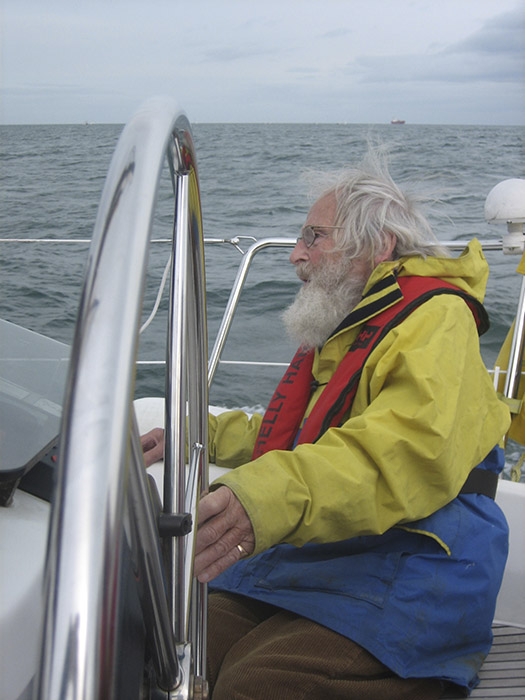
Still at it. Mickey d’Alton at the helm of John Latham’s Beneteau Oceanis 311 Seasaw in 2009. Photo: Sonda d’Alton
This remarkable partnership afloat lasted for wellnigh fifteen years. In time Leslie passed on, then Franz died, yet although Siamsa was sold, Mickey continued sailing until quite recently with John Latham, Leslie’s son, on his Beneteau Oceanis 311 Seasaw, while his love remains undimmed for the remote places once best visited by cruising boats, and particularly the west of Ireland,
Until sixteen months ago when he received his military honours, Mickey d’Alton was best known as a sailing man, and in the world of sailing it was in the inner circles of cruising that he was most highly regarded. Over the years, his awards have included the Faulkner Cup of the Irish Cruising Club in 1956 and 1961, the ICC’s Round Ireland Cup in 1964, and the same club’s Wybrants Cup in 1983 and 1986, its Fingal Cup in 1990, and the Fortnight Cup – for a cruise to the Isles of Scilly in the little Siamsa – in 1997.
In addition, there would be a host of trophies from offshore races of varying lengths, and from inshore racing in Dublin Bay. And then sixteen months ago he became a Chevalier de la Legion d’Honneur and a holder of the USV Distinguished Services Award. He was a great man. Our heartfelt condolences go to his son Mark and his daughter Sonda and to Mickey d’Alton’s many friends and shipmates.
WMN



























